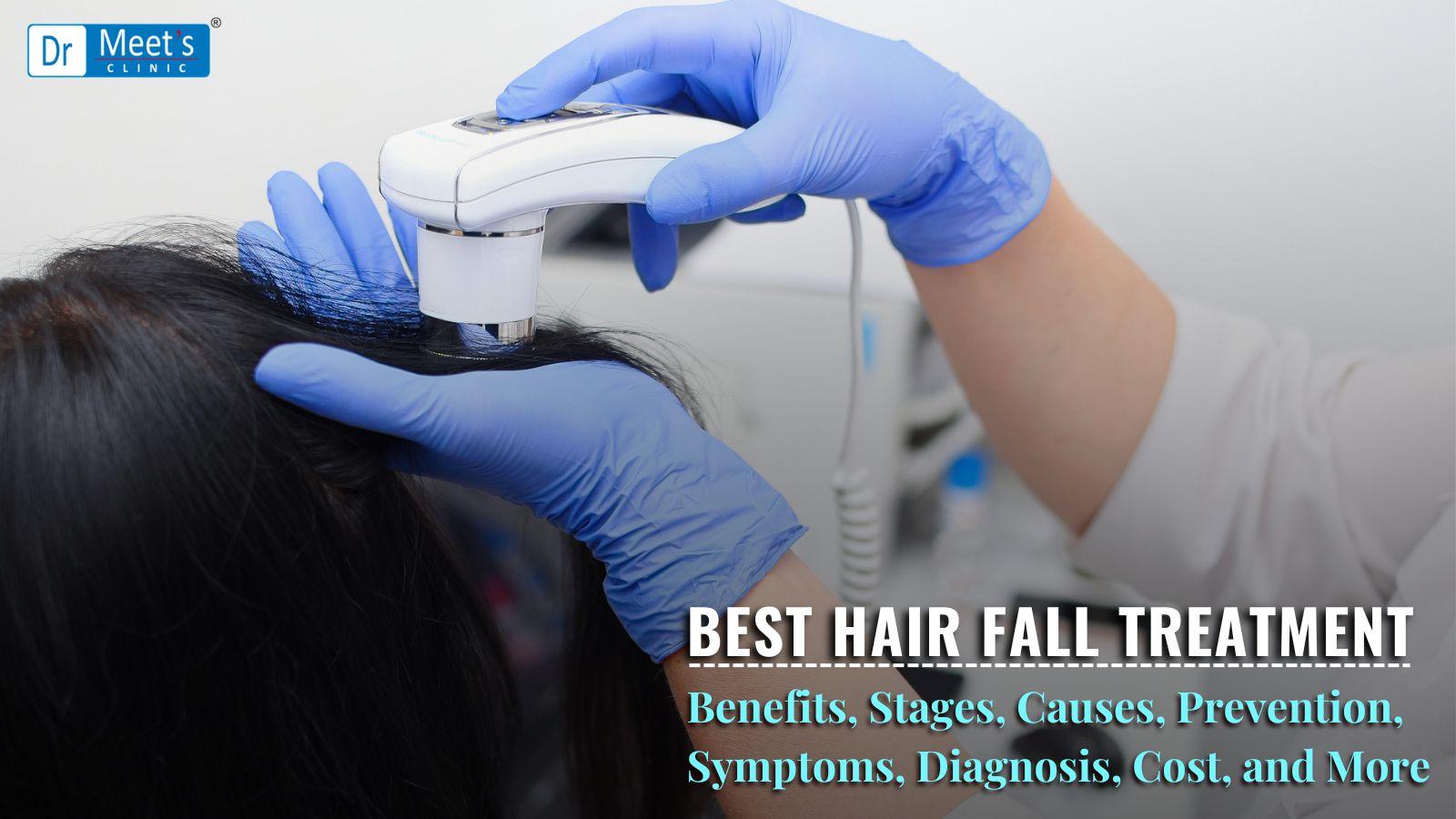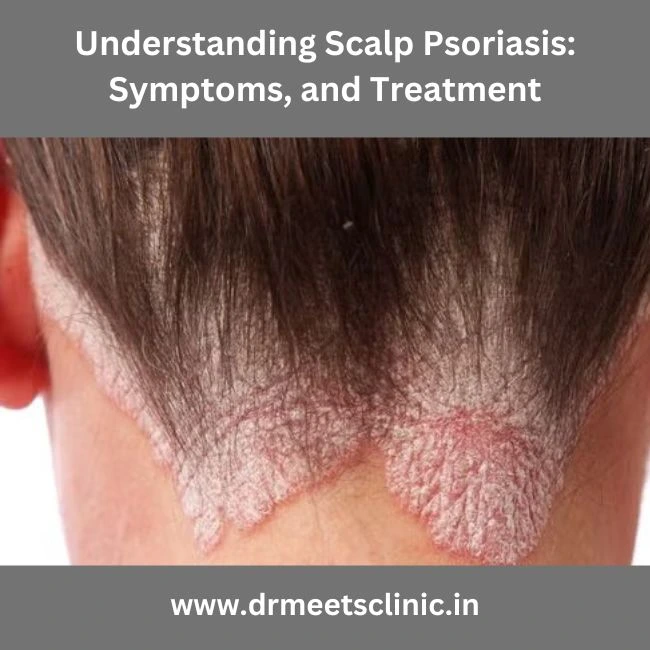A typical adult head has between 100,000 and 150,000 hairs, and up to 100 of those can fall out every day. While this is normal and not a cause for alarm, losing more hair than this may indicate alopecia, a condition of severe hair loss affecting men, women, and children. Certain forms of hair loss are irreversible, whereas others are only temporary. If you’re struggling with persistent hair fall and seeking the best hair fall treatment in Indore, you’re not alone.
Hair loss is a common concern for millions, and finding the right solution can significantly enhance your appearance and self-confidence. Indore, known for its advanced medical facilities, offers various effective hair fall and hair loss treatments for hair regrowth tailored to individual needs. Whether you’re experiencing early stages of hair thinning or more severe hair loss, discovering the best hair loss treatment in Indore is crucial. This comprehensive guide covers the benefits, stages, causes, importance, prevention, symptoms, diagnosis, and cost of hair fall treatment in Indore, ensuring you find the most suitable solution for your needs.
Common Causes of Hair Fall
Hair loss, medically known as alopecia, can occur due to a variety of reasons. The causes can be broadly categorized into genetic, hormonal, medical, and environmental factors.
- Genetics: The most common cause of hair fall is androgenetic alopecia, also known as male or female pattern baldness. This condition is inherited and can start as early as puberty.
- Hormonal Changes: Pregnancy, delivery, menopause, and thyroid issues can all lead to hair loss.
- Medical Conditions: Diseases like alopecia areata, scalp infections, and other skin disorders can lead to hair loss.
- Medications: Drugs used for cancer, Radiation therapy to the head. , arthritis, depression, heart problems, and high blood pressure can cause hair fall as a side effect.
- Nutritional Deficiencies: Lack of essential nutrients such as iron, protein, and vitamins can weaken hair, leading to loss.
- Stress and Lifestyle: Chronic stress, lack of sleep, and unhealthy lifestyle choices can contribute to hair fall.
- Hairstyles and treatments. Traction alopecia is a kind of hair loss that can be brought on by excessive hairstyling or pulling your hair tight in styles like cornrows or pigtails. Hair loss can also result from permanent hair color and hot oil hair treatments.
Stages of Hair Loss
Hair loss can be distressing, but understanding the stages can help manage expectations and explore treatment options. Here are the different stages of hair loss:
Stage 1: Minimal Hair Loss
- Description: Very slight thinning or recession at the hairline.
- Signs: Hair looks generally full; changes are barely noticeable.
Stage 2: Receding Hairline
- Description: Noticeable hair loss near the temples (skin between your ears and forehead).
- Signs: Formation of a V-shaped pattern at the front; hairline starts to move back.
Stage 3: Early Baldness
- Description: Deeper recession at the temples, forming an M, U, or V shape.
- Signs: Clearer signs of hair loss, possibly including thinning at the crown.
Stage 4: Significant Thinning
- Description: Advanced hairline recession combined with noticeable thinning at the crown.
- Signs: A band of hair separates the thinning crown from the receding hairline.
Stage 5: Balding Areas Widen
- Description: Thinning areas at the crown and front start to merge.
- Signs: Reduced hair density; the bridge of hair between the crown and hairline narrows.
Stage 6: Extensive Hair Loss
- Description: The bridge of hair disappears, leaving only hair on the sides and back.
- Signs: Crown and hairline areas are largely bald; remaining hair forms a horseshoe shape.
Stage 7: Severe Baldness
- Description: Only a thin ring of hair remains around the sides and back of the scalp.
- Signs: Most of the scalp is bald, with hair only on the lower sides and back.
Understanding these stages helps in identifying the severity of hair loss and determining the most appropriate treatments. Early intervention can often slow the progression and improve hair health.
Types OF Hair Loss
Hair loss can occur due to various reasons and manifests in different forms. Understanding the types of hair loss can aid in identifying the underlying causes and selecting appropriate treatments.
Androgenetic Alopecia (Pattern Baldness)
- Description: The most common form of hair loss, affects both men and women.
- Signs: Gradual thinning and receding hairline in men; thinning at the crown and widening part in women.
- Causes: Genetics and hormonal changes.
Alopecia Areata
- Description: An autoimmune disorder where the immune system attacks hair follicles.
- Signs: Sudden onset of round, smooth bald patches on the scalp or other body parts.
- Causes: Immune system dysfunction, stress, or other autoimmune conditions.
Telogen Effluvium
- Description: Temporary hair loss due to a disruption in the hair growth cycle.
- Signs: Diffuse thinning across the scalp, noticeable after a stressful event.
- Causes: Physical or emotional stress, illness, surgery, or hormonal changes.
Anagen Effluvium
- Description: Rapid hair loss during the anagen (growth) phase of the hair cycle.
- Signs: Significant hair shedding, often occurring shortly after exposure to the trigger.
- Causes: Chemotherapy, radiation, or toxic exposure.
Traction Alopecia
- Description: Hair loss caused by continuous tension or pulling on the hair.
- Signs: Thinning or bald spots in areas under tension, such as the hairline or temples.
- Causes: Tight hairstyles like ponytails, braids, or extensions.
Cicatricial (Scarring) Alopecia
- Description: A group of rare disorders causing permanent hair loss due to scarring.
- Signs: Bald patches with signs of inflammation, redness, or scaling.
- Causes: Inflammation from autoimmune diseases, infections, or other conditions.
Trichotillomania
- Description: A psychological condition where individuals compulsively pull out their hair.
- Signs: Patchy hair loss with broken hairs of varying lengths.
- Causes: Emotional or psychological stress, often linked to anxiety or obsessive-compulsive disorder.
Symptoms For Hair Fall/Loss
Hair loss can present itself in many ways depending on the underlying reason. These are some common indicators to be aware of:
Gradual Thinning on Top of the Head:
- Description: This is the most common type of hair loss, affecting both men and women as they age.
- Signs: In men, it often begins at the hairline, which recedes over time. In women, it typically results in a broadening of the part in their hair.
Circular or Patchy Bald Spots:
- Description: Some people experience smooth, coin-sized bald spots, usually on the scalp.
- Signs: These spots can also appear on beards or eyebrows. The skin might become itchy or painful before the hair falls out.
Sudden Loosening of Hair:
- Description: Hair may become loose due to either a physical or emotional shock.
- Signs: Whenever you comb or wash your hair, or even just gently tug on it, handfuls of hair may fall out. This form of hair loss usually results in overall hair thinning, however it is transitory.
Full-Body Hair Loss:
- Description: Some conditions and medical treatments, like chemotherapy, can result in the loss of hair all over your body.
- Signs: Hair usually grows back after the treatment ends.
Scaling patches that extend across the scalp:
- Description: This is an indication of ringworm, which can also cause damaged hair, redness, swelling, and leaking.
- Signs: The affected area may be itchy and inflamed.
Diagnosis of Hair Loss or Hair Fall
A comprehensive diagnosis by a hair specialist in Indore is crucial. Diagnostic methods include:
Medical History:
- Description: A detailed medical history is taken to identify any underlying health conditions, medications, or genetic factors contributing to hair loss.
- Considerations: Family history of hair loss, recent illnesses, stress levels, dietary habits, and any hormonal changes.
Physical Examination:
- Description: The scalp and hair are visually examined to assess the pattern and extent of hair loss.
- Signs to Look For: Thinning, bald patches, scalp conditions such as redness or scaling, and hair shaft abnormalities.
Pull Test:
- Description: Several hairs are gently pulled to see how many come out.
- Purpose: Helps to determine the shedding phase and the severity of hair loss.
Scalp Biopsy:
- Description: A small section of scalp skin is removed and examined under a microscope.
- Purpose: Helps to diagnose conditions such as alopecia areata, scarring alopecia, or other scalp disorders.
Blood Tests:
- Description: Blood samples are taken to check for underlying medical conditions.
- Tests Include: Thyroid function tests, hormone levels (androgens, estrogens), complete blood count (CBC), and nutritional deficiencies (iron, vitamin D, etc.).
Dermatoscopy:
- Description: A dermatoscope is used to examine the scalp and hair follicles more closely.
- Purpose: Provides a detailed view of the scalp, helping to identify patterns of hair loss and signs of scalp disease.
Hair Analysis:
- Description: Hair samples are examined to check for structural abnormalities.
- Purpose: Determines the health and integrity of the hair shaft.
Trichoscopy:
- Description: A non-invasive technique using a special magnifying device to examine the scalp and hair.
- Purpose: Helps in diagnosing different types of hair loss and scalp conditions by providing a magnified view.
The Importance of Early Hair Loss Treatment
Timely intervention is key to effective hair fall treatment. Delaying treatment can lead to more extensive hair loss, which might require more invasive procedures like hair transplants. Early treatment can help in:
1) Prevention of Further Damage: Addressing hair loss early can prevent further damage to hair follicles, potentially halting or slowing down the progression of hair loss.
2) Increased Treatment Success: Early treatment often leads to better treatment outcomes, as hair follicles that are still active may respond more favorably to interventions.
3) Preservation of Self-Esteem: Hair loss can significantly impact self-esteem and confidence. Early treatment can help preserve self-esteem by addressing the issue before it becomes more noticeable or severe.
4) Minimization of Psychological Distress: Hair loss can cause significant psychological distress, including anxiety and depression. Early treatment can alleviate these emotional burdens associated with hair loss.
5) Preventive Measures: Early treatment can involve preventive measures to address underlying causes of hair loss, such as nutritional deficiencies or hormonal imbalances before they worsen.
6) Avoidance of Invasive Procedures: Early treatment may prevent the need for more invasive procedures in the future, such as hair transplant surgery.
7) Cost-Effectiveness: Treating hair loss early may be more cost-effective in the long run, as it can prevent the need for more extensive and expensive treatments down the line.
8) Improved Quality of Life: By addressing hair loss early, individuals can maintain a higher quality of life, with less disruption to their daily activities and relationships.
Best Hair Fall Treatments Available in Indore
A wide range of hair loss treatments Available In Indore, from non-invasive therapies to Topical Treatments. Here are some of the most popular and effective anti-hair fall treatments available in Indore:
Medications:
- Minoxidil (Rogaine): A topical solution applied to the scalp, Minoxidil stimulates hair follicles, prolongs the hair growth phase, and increases hair thickness. It’s available over-the-counter.
- Finasteride (Propecia): An oral medication prescribed for men, Finasteride blocks the conversion of testosterone to dihydrotestosterone (DHT), a hormone that contributes to hair loss. It helps in reducing hair loss and promoting hair regrowth.
Surgical Procedures:
- Hair Transplant Surgery: Involves harvesting hair follicles from donor areas and transplanting them into bald or thinning areas. This procedure provides permanent results and natural-looking hair.
- Scalp Reduction: A surgical procedure to remove bald scalp and stretch hair-bearing scalp over the bald areas, reducing the balding area’s size.
Platelet-Rich Plasma (PRP) Therapy:
- Platelets are extracted from a patient’s blood and injected into the scalp. Growth factors found in PRP stimulate hair follicles, encouraging the growth and thickness of new hair. PRP includes growth factors that activate hair follicles, resulting in increasing hair growth and thickness.
Low-Level Laser Therapy (LLLT):
- Low-level laser light is used to stimulate hair follicles, enhance blood flow to the scalp, and encourage hair growth. LLLT devices can be used at home as well as in the clinic.
Nutritional Supplements:
- Biotin, vitamins (like A, C, D, and E), minerals (like iron and zinc), and omega-3 fatty acids are often recommended to support healthy hair growth. These supplements can help address nutrient deficiencies that contribute to hair loss.
Topical Treatments:
- Aside from Minoxidil, other topical treatments like ketoconazole shampoo, corticosteroids, and hair growth serums containing peptides or botanical extracts may be prescribed or recommended to address specific types of hair loss.
Lifestyle Changes:
- Stress management techniques, maintaining a balanced diet, avoiding harsh hair treatments, and practicing good scalp hygiene can help improve overall hair health and reduce hair loss.
Cosmetic Solutions:
- Hairpieces, wigs, and hair fibers offer immediate solutions for concealing hair loss and restoring a fuller appearance. They are available in a variety of styles, colors, and materials to meet individual preferences.
Natural Remedies:
- Essential oils like rosemary, peppermint, and lavender oil, as well as herbal supplements like saw palmetto and pumpkin seed oil, are sometimes used as natural remedies to promote hair growth. However, there is limited scientific data to support their efficacy.
Preventive Measures for Hair Loss
Preventing hair loss can be challenging, but certain measures can help maintain healthy hair and reduce the risk of extensive loss:
1) Healthy Diet: Consume a balanced diet rich in vitamins, minerals, and proteins essential for hair health. Include foods like fruits, vegetables, lean proteins, and whole grains to support strong, healthy hair growth.
2) Stress Management: Reduce your stress by engaging in stress-reduction practices like yoga, meditation, or deep breathing exercises. Developing stress management techniques is essential because long-term stress may lead to hair loss.
3) Gentle Hair Care: Avoid over-processing your hair with harsh chemicals, frequent heat styling, or tight hairstyles that can damage hair follicles. Use gentle shampoos and conditioners that are best for your hair type and scalp conditions.
4) Scalp Care: Wash your scalp with a mild shampoo on a regular basis to keep it healthy and clean. Avoid excessive scratching or rubbing, as this can damage hair follicles and contribute to hair loss.
5) Avoid Smoking and Excessive Alcohol: Smoking and excessive alcohol consumption can impair blood circulation to the scalp, depriving hair follicles of essential nutrients and oxygen. Quitting smoking and moderating alcohol intake can help promote healthy hair growth.
6) Protect Your Hair from the Sun and Environmental Damage: Wear a hat or use a sunscreen spray to protect your scalp and hair from the damaging effects of UV radiation and environmental pollutants.
7) Stay Hydrated: To keep your entire body and scalp hydrated throughout the day, drink plenty of water. Proper hydration supports overall hair health and growth.
8) Address Underlying Health Conditions: Treat underlying health conditions such as thyroid disorders, hormonal imbalances, or scalp infections promptly, as they can contribute to hair loss if left untreated.
9) Scalp Massage: Gently massage your scalp regularly to improve blood flow and stimulate hair follicles. Use natural oils like coconut or almond oil for added nourishment and hydration.
10) Avoid Chemical Treatments: Be cautious with chemical treatments such as hair dyeing, bleaching, and perming, as these can weaken the hair and make it more prone to breakage and loss. Consider natural or less harsh alternatives.
Benefits and Advantages Of Hair Fall Treatment
Hair fall treatment offers numerous benefits and advantages for individuals experiencing hair loss. Here are some key benefits:
- Improved Confidence: Hair fall treatment can significantly boost self-esteem and confidence by restoring a full and healthy-looking head of hair. Feeling satisfied with one’s appearance can have a favorable impact on general well-being.
- Enhanced Appearance: Treating hair fall can result in thicker, denser hair, enhancing the overall appearance and making individuals look younger and more attractive.
- Prevention of Further Hair Loss: Certain treatments not only promote hair regrowth but also help prevent future hair loss, providing long-term benefits.
- Increased Social Confidence: With restored hair, individuals may feel more confident in social situations, leading to increased social interactions and improved relationships.
- Professional Advancement: Studies suggest that individuals with a full head of hair are often perceived as more competent and successful in professional settings. Hair fall treatment can, therefore, positively impact career prospects and advancement opportunities.
- Improved Hair and Scalp Health: Many hair fall treatments improve the overall health of the hair and scalp, reducing issues such as dandruff, dryness, and itching.
- Long-Term Results: Depending on the treatment chosen, the benefits of hair fall treatment can be long-lasting, providing ongoing satisfaction and confidence.
- Enhanced Quality of Life: Ultimately, addressing hair fall through treatment improves overall quality of life by restoring confidence, reducing stress, and enhancing appearance.
By addressing hair fall through treatment, individuals can enjoy a range of benefits that positively impact various aspects of their lives, from confidence and appearance to mental and emotional well-being.
Cost of Hair Fall Treatment in Indore
The cost of hair fall treatment in Indore can vary depending on several factors, including the type of treatment chosen, the severity of the hair loss, the clinic or facility where the treatment is performed, and any additional services or procedures required. It’s essential to consult with Dr. Meet’s Clinic to discuss the specific treatment options available for hair fall with their associated costs. Additionally, factors such as the number of treatment sessions needed and any follow-up care required can also affect the overall cost of hair fall treatment in Indore.
Common Myths About Hair Loss and Treatments
Hair loss is a major problem that many people experience globally. However, there are several myths and misconceptions surrounding hair loss and its treatments. Here are a few of the most general myths dispelled:
1) Myth: Wearing helmets or caps leads to hair loss.
- Reality: Wearing hats or helmets does not directly cause hair loss. However, wearing tight headgear for prolonged periods may lead to traction alopecia, a type of hair loss caused by constant pulling or tension on the hair follicles.
2) Myth: Only men experience hair loss.
- Reality: While hair loss is more commonly associated with men, it can affect both men and women. Female pattern hair loss is a common condition characterized by thinning of the hair on the scalp.
3) Myth: Hair loss is always hereditary.
- Reality: While genetics can play a significant role in hair loss, other factors such as hormonal changes, medical conditions, medications, and lifestyle habits can also contribute to hair loss.
4) Myth: Trimming your hair frequently promotes faster growth.
- Reality: Cutting your hair does not affect its growth rate. Hair growth occurs at the hair follicles located beneath the scalp, and cutting the hair shaft has no impact on the rate at which hair grows.
5) Myth: Massaging the scalp will prevent hair loss.
- Reality: While scalp massage can improve blood circulation and promote relaxation, there is limited scientific evidence to support its effectiveness in preventing hair loss. However, scalp massage may help improve the health of the scalp and hair follicles.
6) Myth: Hair loss treatments are only effective for certain types of hair loss.
- Reality: There are various treatments available for different types of hair loss, including male and female pattern baldness, alopecia areata, and telogen effluvium. However, the effectiveness of treatment may vary depending on the underlying cause of hair loss and individual factors.
7) Myth: Using hair products causes hair loss.
- Reality: While some hair products may contain harsh chemicals or ingredients that can damage the hair and scalp, using high-quality, gentle hair care products is unlikely to cause hair loss. However, excessive styling, heat, or chemical treatments can weaken the hair and contribute to breakage or hair loss over time.
Understanding the truth behind these common myths can help individuals make informed decisions about hair loss prevention and treatment. It’s essential to consult with the best trichologist In Indore or Best Hair Specialist In Indore for personalized advice and recommendations based on individual needs and concerns.
Choosing the Best Hair Specialist in Indore
Choosing the right hair specialist in Indore is crucial for effectively treating and managing these issues. Dr. Meet, a trusted trichologist in Indore, offers comprehensive expertise and personalized care for various hair concerns.
As a trichologist, Dr. Meet specializes in diagnosing and treating conditions affecting the scalp anWith years of experience and an extensive knowledge of hair biology, Dr. Meet employs advanced diagnostic techniques and evidence-based treatments to address your specific needs.
When selecting a hair specialist, it’s essential to consider their qualifications, experience, and track record of success. Dr. Meet’s Clinic stands out for its commitment to patient satisfaction, providing compassionate care and effective solutions tailored to each individual.
Whether you’re experiencing early signs of hair thinning or more advanced hair loss, Dr. Meet offers a range of treatments to promote hair growth, improve hair density, and restore your confidence. From FDA-approved medications and innovative procedures to holistic approaches and lifestyle recommendations, Dr. Meet adopts a comprehensive approach to address your hair concerns.
Conclusion
In conclusion, addressing hair fall requires a comprehensive approach encompassing diagnosis, treatment, and preventive strategies. Indore offers a conducive environment for individuals seeking the best hair fall treatment in Indore, with its skilled hair specialist, advanced treatment modalities, and personalized care. By understanding the benefits, stages, causes, importance, prevention measures, symptoms, diagnosis, and costs associated with hair fall treatment in Indore, individuals can make informed decisions to reclaim their confidence and restore their hair’s health. Remember, investing in hair fall treatment is not just about regaining lost hair but also about embracing a renewed sense of self-assurance and well-being.
FAQs Related To Hair Fall/Loss Treatment
Q. What is the best and most effective treatment for hair loss?
Ans. Depending on the cause and the circumstances of the hair loss, many treatments work best. Treatments range from drugs like minoxidil and finasteride to more advanced alternatives such as PRP therapy and hair transplants.
Q. How much hair Fall is normal in one day?
Ans. Regularly, shedding 50 to 100 hairs per day is considered normal. Hair washing frequency and length can both have an impact on daily hair loss. If you observe more hair fall than this, it may be time to seek further assistance.
Q. How long does it take to notice results from a hair loss treatment?
Ans. The timeline for seeing results from hair fall treatment varies depending on the treatment method and individual response. Some treatments may require several sessions before noticeable improvement occurs.
Q. Are hair fall treatments safe?
Ans. Generally, hair fall treatments offered in reputable clinics in Indore are safe when administered by qualified professionals. However, it’s essential to follow the recommended guidelines and instructions provided by your healthcare provider.
Q. Are there any negative impacts of hair loss treatment?
Ans. Side effects of hair fall treatment are minimal and generally temporary. However, some treatments may carry risks such as scalp irritation, redness, or mild discomfort, which are usually mild and resolve on their own.
Q. How can I schedule a consultation for hair fall treatment With the best Hair Specialist in Indore?
Ans. Please contact Dr. Meet’s Clinic to schedule a consultation with a trusted trichologist in Indore. Dr. Meet will assess your condition and recommend the most suitable treatment plan to address your hair fall concerns.

















